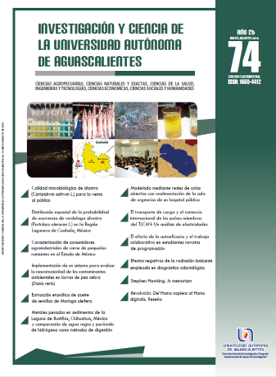Implementación de un sistema para evaluar la neurotoxicidad de los contaminantes ambientales en larvas de pez cebra (Danio rerio)
DOI:
https://doi.org/10.33064/iycuaa2018741718Palabras clave:
pez cebra, neurotoxicidad, tiametoxam, atrazina, arsénico, plaguicidasResumen
En la actualidad, una amplia gama de contaminantes son detectados en el ambiente con implicaciones en la salud y en la biodiversidad, su elevado número ha dificultado su estudio con métodos de experimentación in vitro e in vivo. Se implementó en el modelo del pez cebra un sistema de bajo costo para evaluar el efecto de los contaminantes ambientales, utilizando la actividad motora como marcador de neurotoxicidad. Embriones fueron expuestos a concentraciones de 0.05, 0.5, 5, 50 mg/l de arsénico inorgánico (Asi), 0.03, 0.3, 3, 10 mg/l de atrazina (ATR) y 14.5, 29.1, 43.6 mg/l de tiametoxam (TMX). La actividad motora aumentó en larvas expuestas a ATR y Asi y disminuyó con dosis altas de TMX. Estos datos sugieren que el sistema implementado es sensible para detectar cambios en la conducta motora en larvas del pez cebra, lo que puede contribuir positivamente al estudio de los contaminantes ambientales.
Descargas
Citas
• Bardullas, U., Giordano, M., & Rodríguez, V. M. (2011). Chronic atrazine exposure causes disruption of the spontaneous locomotor activity and alters the striatal dopaminergic system of the male Sprague-Dawley rat. Neurotoxicology and Teratology, 33(2), 263-272.
• Bardullas, U., Limón-Pacheco, J. H., Giordano, M., Carrizales, L., Mendoza-Trejo, M. S., & Rodríguez, V. M. (2009). Chronic low-level arsenic exposure causes gender-specific alterations in locomotor activity, dopaminergic systems, and thioredoxin expression in mice. Toxicology and Applied Pharmacology, 239(2), 169-177.
• Calderón, J., Navarro, M. E., Jimenez-Capdeville, M. E., Santos-Diaz, M. A., Golden, A., Rodriguez-Leyva, I.,… Diaz-Barriga, F. (2001). Exposure to arsenic and lead and neuropsychological development in Mexican children. Environmental Research, 85(2), 69-76.
• Camacho, L. M., Gutiérrez, M., Alarcón-Herrera, M. T., Villalba, M. L., & Deng, S. (2011). Occurrence and treatment of arsenic in groundwater and soil in northern Mexico and southwestern USA. Chemosphere, 83(3), 211-225.
• Cao, J., Xu, X., Hylkema, M. N., Zeng, E. Y., Sly, P. D., Suk, W. A., … Huo, X. (2016). Early-life exposure to widespread environmental toxicants and health risk: A focus on the immune and respiratory systems. Annals of Global Health, 82(1), 119-131.
• Crofton, K. M., Howard, J. L., Moser, V. C., Gill, M. W., Reiter, L. W., Tillson, H. A., & MacPhail, R. C. (1991). Interlaboratory comparison of motor activity experiments: Implications for neurotoxicological assessments. Neurotoxicology and Teratology, 13(6), 599-609.
• Crosby, E. B., Bailey, J. M., Oliveri, A. N., & Levin, E. D. (2015). Neurobehavioral impairments caused by developmental imidacloprid exposure in zebrafish. Neurotoxicology and Teratology, 49, 81-90.
• Del Razo, L. M., Garcia-Vargas, G. G., Garcia-Salcedo, J., Sanmiguel,
M. F., Rivera, M., Hernandez, M. C., & Cebrian, M. E. (2002). Arsenic levels in cooked food and assessment of adult dietary intake of arsenic in the Region Lagunera, Mexico. Food and Chemical Toxicology, 40(10), 1423-1431.
• Eaton, D. L., & Gallagher, E. P. (2010). 1.01 –General overview of Toxicology. En Comprehensive Toxicology (vol. 1, pp. 1-46). US: Elsevier.
• Hoy, J. B., Cody, B. A., Karlix, J. L., Schmidt, C. J., Tebbett, I. R., Toffollo, S., … Wielbo, D. (1999). Pyridostigmine bromide alters locomotion and thigmotaxis of rats: Gender effects. Pharmacology, Biochemistry, and Behavior, 63(3), 401-406.
• Lieschke, G. J., & Currie, P. D. (2007). Animal models of human disease: Zebrafish swim into view. Nature Reviews. Genetics, 8(5), 353-367.
• Liu, Z., Wang, Y., Zhu, Z., Yang, E., Feng, X., Fu, Z., & Jin, Y. (2016). Atrazine and its main metabolites alter the locomotor activity of larval zebrafish (Danio rerio). Chemosphere, 148, 163-170.
• LSRtrack (s. f.). PRICA_Analyze.zip [Carpetas con información]. Recuperado de https://drive.google.com/file/d0B3eZrxIrQPe5OFRpaGpzaUNabkk/view?usp=sharing
• Nagel, R. (2002). DarT: The embryo test with the Zebrafish Danio rerio--a general model in ecotoxicology and toxicology. ALTEX, 19(Suppl. 1), 38-48.
• Peterson, R. T., & MacRae, C. A. (2012). Systematic approaches to toxicology in the zebrafish. Annual Review of Pharmacology and Toxicology, 52, 433-453.
• Schnörr, S. J., Steenbergen, P. J., Richardson, M. K., & Champagne, D. L. (2012). Measuring thigmotaxis in larval zebrafish. Behavioural Brain Research, 228(2), 367-374.
• Steenbergen, P. J., Richardson, M. K., & Champagne, D. L. (2011). The use of the zebrafish model in stress research. Progress in Neuro-psychopharmacology & Biological Psychiatry, 35(6), 1432-1451.
• Stewart, A. M., Gaikwad, S., Kyzar, E., & Kalueff, A. V. (2012). Understanding spatio-temporal strategies of adult zebrafish exploration in the open field test. Brain Research, 1451, 44-52.
• Tolins, M., Ruchirawat, M., & Landrigan, P. (2014). The developmental neurotoxicity of arsenic: cognitive and behavioral consequences of early life exposure. Annals of Global Health, 80(4), 303-314.
• Tomizawa, M., & Casida, J. E. (2003). Selective toxicity of neonicotinoids
attributable to specificity of insect and mammalian nicotinic receptors. Annual Review of Entomology, 48, 339-364.
• Wolansky, M. J., Gennings, C., DeVito, M. J., & Crofton, K. M. (2009). Evidence for dose-additive effects of pyrethroids on motor activity in rats. Environmental Health Perspectives, 117(10), 1563-1570.
• Zhou, Y., Cattley, R. T., Cario, C. L., Bai, Q., & Burton, E. A. (2014).
Quantification of larval zebrafish motor function in multiwell plates using open-source MATLAB applications. Nature Protocols, 9(7), 1533-1548.
Descargas
Publicado
Cómo citar
Licencia
Las obras publicadas en versión electrónica de la revista están bajo la licencia Creative Commons Atribución-NoComercial-CompartirIgual 4.0 Internacional (CC BY-NC-SA 4.0)









